Unpretentious late-ripening cabbage variety Stone Head
Stone head cabbage has been popular in Russia for more than 10 years. The vegetable is suitable for growing both in garden plots and on an industrial scale. The culture shows good resistance to autumn frosts, high summer temperatures and drought. You will find a detailed description of the Stone Head cabbage variety with photos and reviews in this article.
Description of the cabbage variety Stone Head
Cabbage is capable of forming dense forks. It is very difficult to cut because the leaves are located as close to each other as possible. The variety is characterized by excellent taste and special sweetness, but the leaves lack juiciness.
The stone head appeared in Poland. It is recommended for cultivation in unprotected areas in the European part of Russia, in the South, in a greenhouse. During the entire cultivation period, the cabbage showed compliance with the varietal characteristics.
In 2006, the variety was included in the State Register of the Russian Federation.
Chemical composition, beneficial properties
The nutritional value of 100 g of fresh product is presented in the table:
| Compound | Indicators (g) | % of RSP |
| Squirrels | 1,8 | 1,96 |
| Fats | 0,2 | 0,3 |
| Carbohydrates | 4,7 | 3,36 |
| Alimentary fiber | 2 | 10 |
| Water | 90 | 3,3 |
| Calorie content - 28 kcal, percentage of RSP - 1.82% | ||
White cabbage contains a large amount of vitamin B2 (3.9%), B9 (5.5%), C (67%). There is vitamin K (63%), Si (177%), Co (30%), Mg (8.5%).
The stone head has the following beneficial properties: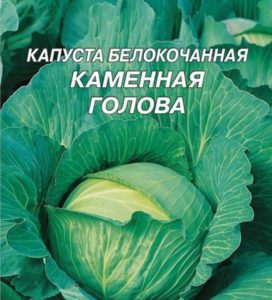
- Cleanses the body of toxins, cholesterol, and harmful substances. Significantly reduces the load on the liver.
- Minimizes the risk of atherosclerosis.
- Maintains normal glucose levels.
- Strengthens and supports immunity.
- Reduces the risk of developing gout.
- Positively affects the functioning of the liver and gall bladder.
- Reduces the risk of developing neoplasms.
- Eases pain.
Eating cabbage is not recommended during lactation. Often the vegetable causes allergies in a newborn.
Features of application
Stone head is consumed fresh, stewed, and boiled. Heads of cabbage are suitable for canning, preparing salads, first and second courses. The leaves are used for medicinal purposes: infusions, decoctions, and juices are prepared.
Ripening time and yield
This is a late ripening variety. When growing from seedlings, the growing season is 115-125 days, when growing from seeds - 140-160 days.
With proper care, gardeners harvest from 8 to 10 kg per 1 m².
Resistance to disease and cold
The variety does not suffer from fusarium, necrosis, rot, or alternaria. The threat mainly comes from slugs and cutworm caterpillars.
Cabbage can withstand the first autumn frosts down to -2°C.
Appearance, taste
Characteristics:
- Cabbage is a medium-sized variety, so it reaches a height of 50 cm. The diameter of the plant’s rosette is 50 cm.
- The leaves are raised, light green in color and have a blue tint. The foliage fits tightly to the fork without forming gaps. The leaves are round in shape with wavy edges. In the center there is an elastic rod with a rigid fibrous structure. The surface of the leaves is glossy with a slight waxy coating.
- The dense head of cabbage has a round shape, slightly flattened on top. Average weight is 4.5 kg. The outside of the forks is green, and the cut is white. The stump is short.
- The growing season of cabbage continues at +8°C. If the harvest was not harvested on time, the heads of cabbage still retain their marketable appearance. The closer the first autumn frosts are, the sweeter the forks become.
Stone head is a variety in its own right. Therefore, it is capable of producing full-fledged seeds for subsequent breeding. They retain good germination (subject to planting rules, it reaches 98%) and the advantages of the parent plant.
What regions is it suitable for?
The variety is adapted to temperate climates. Night and daytime temperature changes do not affect the density and size of the head of cabbage. Cabbage is grown in the European part of Russia, in the South, in the middle zone and Siberia.
Advantages and disadvantages of the Stone Head variety
For more than 10 years, this cabbage has been a leader in terms of cultivation volume and advantages. Among the latter it is noted:
- frost resistance, allowing the variety to be cultivated in open areas and in unprotected greenhouses;
- resistance of cabbage heads to cracking with a deficiency or abundance of moisture;
- excellent preservation of vegetables for 6 months or more without loss of beneficial and taste qualities;
- low maintenance, except for the need for well-lit areas for normal growth;
- resistance to major types of diseases;
- producing a stable harvest of dense heads of cabbage;
- universal application;
- formation of seeds suitable for subsequent sowing;
- good tasting qualities (score 9 out of 10).
The disadvantages include the rigid structure of the upper leaves, demanding soil composition and ultraviolet radiation.
Differences from other varieties and hybrids
The main difference is the high density of heads of cabbage (the leaves do not form gaps when forming forks).Another quality is that Stone Head is an independent variety and is capable of producing full-fledged seeds.
Stone head cabbage: features of planting and growing
The variety is propagated by seeds. You can get planting material yourself or buy it in a store. Cabbage is planted in a permanent place with seeds or seedlings.
In the first case, the ripening time of vegetables increases, in the second, harvesting is accelerated. Experienced gardeners practice both methods, but at the same time recommend following certain planting rules.
Preparing for landing
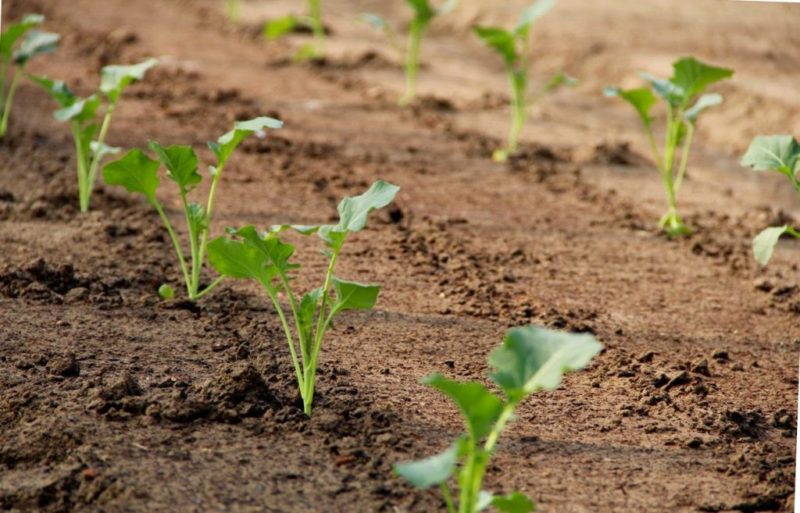
Before planting, determine the method. Then they study the basic recommendations for preparing planting material.
Seed material is sorted and processed to prevent infection with fungal diseases. Instructions for preparing seeds are as follows:
- Specimens measuring 1.5 mm or more are taken for sowing.
- Place them in water with a temperature from +40°C to +50°C for 15-20 minutes. Then the seeds are dipped in cold water.
- Dry, treat with the fungicide “Fitosporin-M” by soaking for 8-18 hours.
Experienced gardeners do not process seeds from the store, but soak them only if desired. But the procedure is mandatory to speed up the germination of the material.
Before planting the seeds, prepare the soil mixture. Use one of the suggested options:
- mix 75% peat, 20% turf soil, 5% sand;
- 45% humus, 50% turf soil and 5% sand;
- 20% each of turf soil, humus, compost, peat and 5% sand.
If you don’t want to prepare the substrate, buy it in the store. A suitable product is designated as soil “For growing seedlings.”
Then the seeds are placed according to the following principle:
- Take a container for seedlings and fill it with prepared soil. Layer height is about 4 cm.
- Water the soil with Alerina-B and Gamaira solutions. To prepare them, dissolve 1 tablet in 10 liters of water.
- Leave the soil for 3 days (minimum time - 1 day).
- Then furrows are formed 1 cm deep, maintaining 3 cm between them.
- Distribute the seeds on the surface so that the distance between them is 1-1.5 cm.
- Sprinkle the seed material with soil.
- Place the containers in a room with a temperature of about +20°C.
After 4-5 days, young plants will appear. The temperature is reduced to +9°C. After 7 days, the seedlings are planted in separate pots. It is advisable that the diameter of the containers be about 8 cm.
Additionally, adhere to the following recommendations:
- To pick young cabbage, use the substrate that was taken for planting the seeds. Add 1 tbsp to the soil. l. double superphosphate (the amount is calculated for one bucket of soil mixture) and 2 tbsp. l. wood ash.
- Place the seedlings for 2-3 days in a room with a temperature of about +18°C. Monitor the quality of lighting. In cloudy weather, additional artificial lighting is used.
- 2 weeks before planting, seedlings are fed. Prepare a solution from 10 liters of water, 1 tbsp. l. urea and 1 tbsp. l. potassium sulfate. 100 ml of solution is enough for one plant.
Non-seedling planting
To do this, choose the right area and prepare the soil.
Choose a well-lit area where the soil has a neutral pH level. In the fall, humus, manure or compost is added to the soil at the rate of 1 bucket per 1 square meter. m plot. In spring, fertilize with a mineral mixture - 2 tbsp. l. urea, superphosphate and wood ash. The soil is being dug up.
The best predecessors are carrots, potatoes, onions, legumes, grains, garlic, cucumber. The worst are representatives of the cabbage family, tomatoes, radishes, beets, and turnips.
Dates, scheme and rules of planting
Cabbage is planted in open ground in the middle or end of May. At this time, the soil warms up to +8°C. The procedure is performed in cloudy weather.
Sowing is done in a checkerboard pattern. Maintain a distance of about 3 cm. Lightly water and cover with agrofibre. After the formation of two true leaves, the seedlings are docked in a checkerboard pattern. For 1 sq. m plot place 3 plants. The holes are made 15 cm deep.
Features of cultivation
Seedlings must be watered and weeded. In sunny, hot weather, the seedlings are covered with large burdock leaves or plastic bottles. Otherwise, the leaves will turn yellow and dry out.
Cabbage requires timely watering, removal of pests, protection from fungal infections, and hilling. Compliance with the following recommendations will ensure a 98% yield.
Watering mode
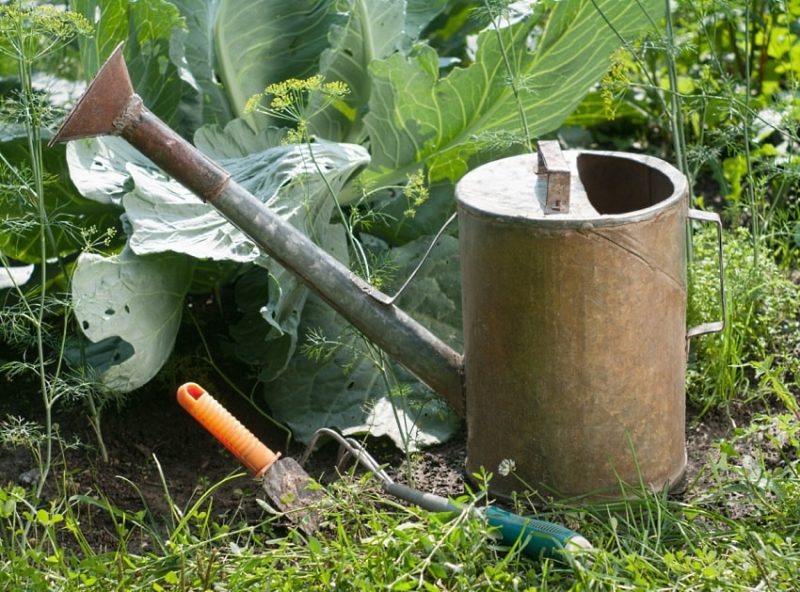
Young cabbage is watered 3-4 times a week with 2-3 liters of water per plant. After 30 days, watering is reduced to once a week, pouring 10-12 liters per 1 square meter. m. The optimal water temperature is not lower than +18°C.
Loosening and hilling
A day after watering, the soil around the seedlings is loosened to a depth of 7 cm. Hilling is done when the plant reaches a height of 50 cm. The second hilling is carried out before the head of cabbage begins to form.
Top dressing
Cabbage requires 3-4 feedings during the entire growing season.
Instructions:
- The seedlings are fed for the first time 2 weeks after the formation of four true leaves with a solution of ammonium nitrate (10 g dissolved in 10 liters of water, 100 ml is poured under one bush);
- the second - 10 days after the first feeding by adding a mixture of ammonium nitrate, superphosphate, potassium chloride (1:2:1, respectively) at the rate of 40-60 g per 1 sq. m;
- the third - 14 days after the second feeding (take ready-made mineral fertilizers with potassium and phosphorus, the dosage is indicated on the package).
Use any ready-made store-bought fertilizer following the manufacturer's instructions. Otherwise, the components will not be useful.
Measures to increase yield
In addition to watering, weeding, loosening and fertilizing, the variety needs high-quality protection. To do this, experienced gardeners plant marigolds, calendula, wormwood, and mint between the seedlings. They will repel insects. Planting sites are changed every 2-3 years to prevent cabbage from becoming infected with fungal infections.
It is better not to pick off the leaves while the forks are ripening. Otherwise, the plant will lose nutrition. The more leaves, the denser the head.
Disease and pest control
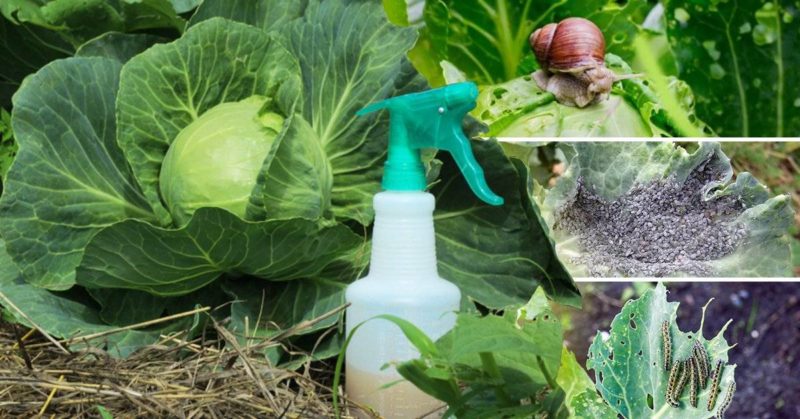
It is recommended to follow a number of measures:
- Before planting cabbage, boil the soil with boiling water to kill overwintering larvae. During digging, all grass is removed along with the roots.
- During watering, make sure that there is no stagnation of moisture. Otherwise, black rot and powdery mildew will begin to spread.
- Collect slugs, destroy armyworm clutches.
- Flowers are planted next to plants to repel pests.
If an insect invasion is observed, the cabbage is treated with Fitoverm and Lepidocide. In the rainy season, use “Karbofos” or “Iskra” against caterpillars, “Metaldehyde” against slugs.
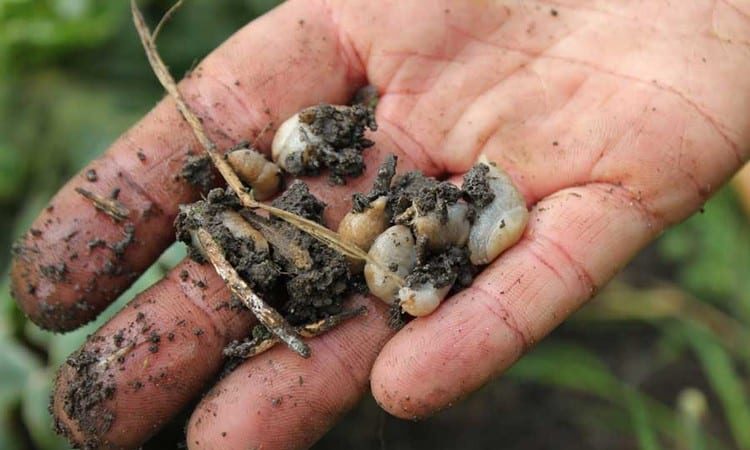
Harvest and storage
Next collection recommendations will help increase the shelf life of heads of cabbage and preserve their beneficial and tasteful qualities.
The harvest is harvested at the end of September or beginning of October, when the air temperature drops to +5°C and the weather is dry. The head of cabbage is cut with a sharp knife so that the height of the stump is about 12 cm.
The remains with roots are removed and burned.
Storage features and keeping quality of the Stone Head variety
For long-term storage, the heads of cabbage are placed in a cellar with a temperature from 0°C to +5°C, good ventilation and humidity of at least 90-95%. The cabbage is laid out in wooden boxes or wrapped in cling film.
In addition to this type of storage, the vegetable is suitable for freezing and pickling. The keeping quality of the variety is excellent, since it retains its properties for 8 months or more.
Tips and reviews from experienced gardeners
Experienced gardeners recommend observing crop rotation, advice on choosing predecessors and a growing site, fighting pests, and ensuring timely watering.
We invite you to read reviews from experienced gardeners about growing this variety.
Valentina, Khanty-Mansiysk: “I have been growing stone head for more than 3 years. This is an excellent variety for our climate. Heads of cabbage withstand autumn temperatures, maintaining density and taste. Growing does not require specific knowledge. It's simple."
Irina, Kursk: “My family likes this variety. The taste of cabbage is not too sweet, but not bitter either. I use heads of cabbage for pickling and stewing. The first harvest lasted until April. However, the forks are not turned black. It’s a good variety, I recommend trying it.”
Conclusion
Stone head is a late-ripening, frost-resistant variety of cabbage that does not require complex agricultural technology. Every beginner can grow it, even with minimal skills. The main thing is to follow all the above tips, harvest the crops in a timely manner and provide the heads of cabbage with comfortable storage conditions.